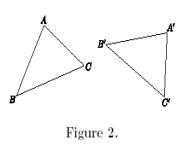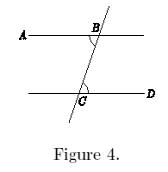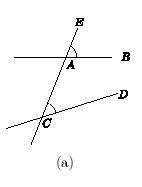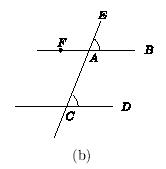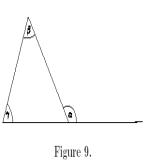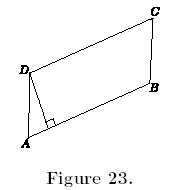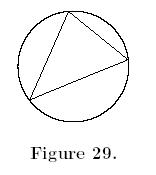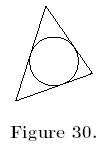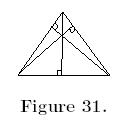Leaving
Cert Geometry
|
|||
Defintions Adapted
from Geometry Syllabus, Appendix 1 |
|
|
|
|
|
Definitions |
|
|
|
1 |
The line
segment [AB] is the part of the line AB between A and B (including the endpoints).
The point A divides the line AB into two pieces, called rays. The point A
lies between all points of one ray and all points of the other. We denote the
ray that starts at A and passes through B by [AB. Rays are sometimes referred
to as half-lines. |
|
|
|
2 |
If three or more points lie on a
single line, we say they are collinear. |
|
|
|
3 |
Let A, B and C be points that are
not collinear. The triangle ∆ABC is the piece of the plane enclosed by the
three line segments [AB], [BC] and [CA]. The segments are called its sides,
and the points are called its vertices (singular vertex). |
|
|
|
4 |
We denote the distance between the points A and B by
|AB|. We define the length of the segment [AB] to be |AB|. |
|
|
|
5 |
The midpoint of the segment [AB]
is the point M of the segment with |AM| = |MB| = |
|
|
|
6 |
A subset of the plane is convex if
it contains the whole segment that connects any two of its points. For example, one side of any line
is a convex set, and triangles are convex sets. We do not define the term angle
formally. Instead we say: There are things called angles. To each angle is
associated: 1. a unique point A, called its
vertex; 2. two rays [AB and [AC, both
starting at the vertex, and called the arms of the angle; 3. a piece of the plane called the
inside of the angle. An angle is either a null angle,
an ordinary angle, a straight angle, a reflex angle or a full angle. Unless
otherwise specified, you may take it that any angle we talk about is an
ordinary angle. |
|
|
|
7 |
An angle is a null angle if its
arms coincide with one another and its inside is the empty set. |
|
|
|
8 |
An angle is an ordinary angle if
its arms are not on one line, and its inside is a convex set. |
|
|
|
9 |
An angle is a straight angle if
its arms are the two halves of one line, and its inside is one of the sides of
that line. |
|
|
|
10 |
An angle is a reflex angle if its
arms are not on one line, and its inside is not a convex set. |
|
|
|
11 |
An angle is a full angle if its
arms coincide with one another and its inside is the rest of the plane. |
|
|
|
12 |
Suppose that A, B, and C are three
noncollinear points. We denote the (ordinary) angle with arms [AB and [AC by Sometimes we want to refer to an
angle without naming points, and in that case we use lower-case greek
letters, α, β, γ, etc. |
|
|
|
13 |
The ray [AD is the bisector of the
angle | |
|
|
|
14 |
A right angle is an angle of
exactly 90o |
|
|
|
15 |
An angle is acute if it has less
than 90o, and obtuse if it has more than 90o. |
|
|
|
16 |
If |
|
|
|
17 |
When two lines AB and AC cross at
a point A, they are perpendicular if |
|
|
|
18 |
Let A lie between B and C on the
line BC, and also between D and E on the line DE. Then opposite angles. |
|
|
|
19 |
Let A, B, C and Á, B´, C´ be triples of non-collinear points. We say that the triangles
∆ABC and ∆A´B´C´ are congruent if all the sides and angles of one are equal to the
corresponding sides and angles of the other, i.e. |AB| = |A´B´|, |BC| = |B´C´|,
|CA| = |C´A´|, | | |
|
|
|
20 |
A triangle is called right-angled
if one of its angles is a right angle. The other two angles then add to 90o,
by Theorem 4, so are both acute angles. The side opposite the right angle is
called the hypotenuse. |
|
|
|
21 |
A triangle is called isosceles if
two sides are equal. It is equilateral if all three sides are equal. It is
scalene if no two sides are equal. |
|
|
|
22 |
Two lines l and m are parallel if
they are either identical, or have no common point. |
|
|
|
23 |
If l and m are lines, then a line
n is called a transversal of l and m if it meets them both. |
|
|
|
24 |
Given two lines AB and CD and a transversal
BC of them, as in Figure 4, the angles |
|
|
|
25 |
Given two lines AB and CD, and a
transversal AE of them, as in Figure 8(a), the angles |
Figure 8
|
|
|
26 |
In Figure 9, the angle α is
called an exterior angle of the triangle, and the angles β and γ
are called (corresponding) interior opposite angles. |
|
|
|
27 |
The perpendicular bisector of a
segment [AB] is the line through the midpoint of [AB], perpendicular to AB. |
|
|
|
28 |
A closed chain of line segments
laid end-to-end, not crossing anywhere, and not making a straight angle at any
endpoint encloses a piece of the plane called a polygon. The segments are
called the sides or edges of the polygon, and the endpoints where they meet
are called its vertices. Sides that meet are called
adjacent sides, and the ends of a side are called adjacent vertices. The
angles at adjacent vertices are called adjacent angles. |
|
|
|
29 |
A quadrilateral is a polygon with
four vertices. Two sides of a quadrilateral that
are not adjacent are called opposite sides. Similarly, two angles of a quadrilateral
that are not adjacent are called opposite angles. |
|
|
|
30 |
A rectangle is a quadrilateral
having right angles at all four vertices. |
|
|
|
31 |
A rhombus is a quadrilateral
having all four sides equal. |
|
|
|
32 |
A square is a rectangular rhombus. |
|
|
|
33 |
A polygon is equilateral if all
its sides are equal, and regular if all its sides and angles are equal. |
|
|
|
34 |
A parallelogram is a quadrilateral
for which both pairs of opposite sides are parallel. |
|
|
|
35 |
If the three angles of one
triangle are equal, respectively, to those of another, then the two triangles
are said to be similar. |
|
|
|
36 |
Let s and t be positive real
numbers. We say that a point C divides the segment [AB] in the ratio s : t if
C lies on the line AB, and is between A and B, and We say that a line l cuts [AB] in
the ratio s : t if it meets AB at a point C that divides [AB] in the ratio s
: t. |
|
|
|
37 |
If one side of a triangle is
chosen as the base, then the opposite vertex is the apex corresponding to
that base. The corresponding height is the length of the perpendicular from
the apex to the base. This perpendicular segment is called an altitude of the
triangle. |
|
|
|
38 |
The area of a triangle is half the
base by the height. |
|
|
|
39 |
Let the side AB of a parallelogram
ABCD be chosen as a base (Figure 23). Then the height of the parallelogram
corresponding to that base is the height of the triangle _ABC. |
|
|
|
40 |
A circle is the set of points at a
given distance (its radius) from a fixed point (its centre). Each line
segment joining the centre to a point of the circle is also called a radius.
The plural of radius is radii. A chord is the segment joining two points of
the circle. A diameter is a chord through the centre. All diameters have
length twice the radius. This number is also called the diameter of the
circle. Two points A, B on a circle cut it
into two pieces, called arcs. You can specify an arc uniquely by giving its
endpoints A and B, and one other point C that lies on it. A sector of a
circle is the piece of the plane enclosed by an arc and the two radii to its
endpoints. The length of the whole circle is
called its circumference. For every circle, the circumference divided by the
diameter is the same. This ratio is called π. A semicircle is an arc of a circle
whose ends are the ends of a diameter. Each circle divides the plane into
two pieces, the inside and the outside. The piece inside is called a disc. If B, and C are the ends of an arc
of a circle, and A is another point, not on the arc, then we say that the
angle |
|
|
|
41 |
A cyclic quadrilateral is one
whose vertices lie on some circle. |
|
|
|
42 |
The line l is called a tangent to
the circle S when l |
|
|
|
43 |
The circumcircle of a triangle
∆ABC is the circle that passes through its vertices (see Figure 29).
Its centre is the circumcentre of the triangle, and its radius is the
circumradius. |
|
|
|
44 |
The incircle of a triangle is the circle
that lies inside the triangle and is tangent to each side (see Figure 30).
Its centre is the incentre, and its radius is the inradius. |
|
|
|
45 |
A line joining a vertex of a
triangle to the midpoint of the opposite side is called a median of the triangle.
The point where the three medians meet is called the centroid. |
|
|
|
46 |
The point where the perpendiculars
from the vertices to the opposite sides meet is called the orthocentre (see
Figure 31). |
|
|
Note: The
official version of Project Maths material may be found through the Project
Maths website www.projectmaths.ie
Page
created by Neil Hallinan © 2010
